Divine Currents : the Ganga and Yamuna in Indian Art
- EIH User
- August 21, 2024
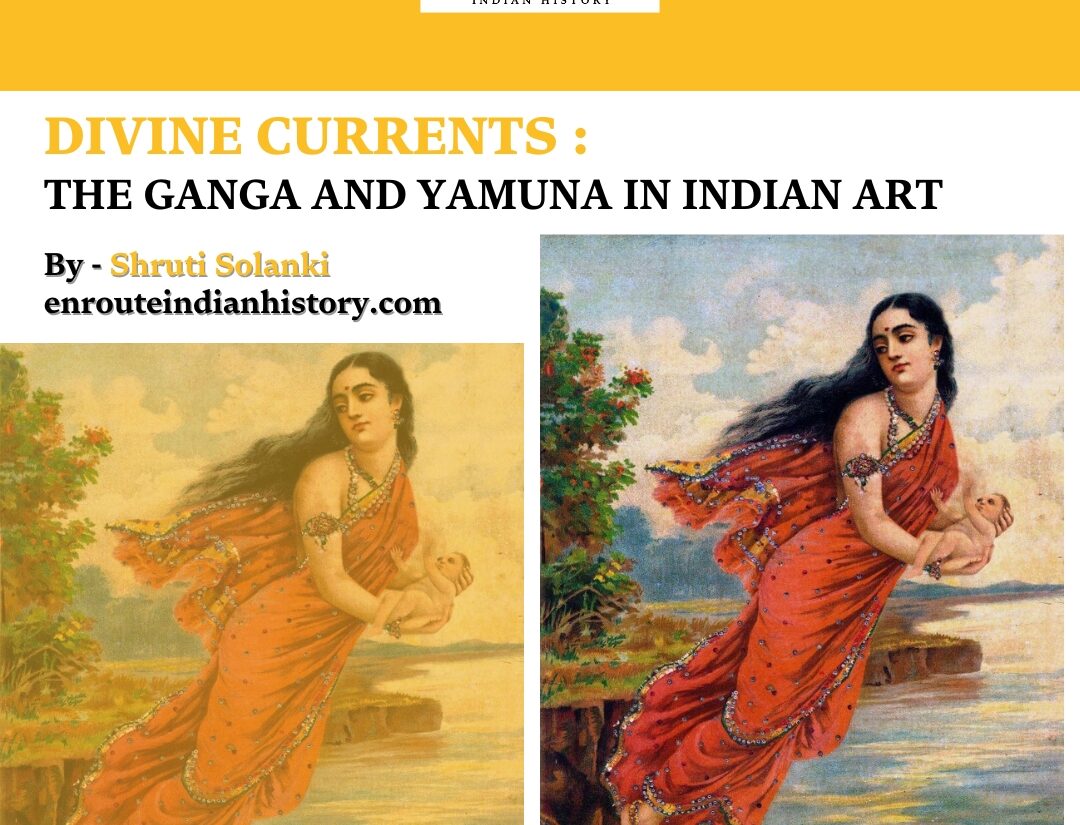
Ganga and Yamuna in Indian Mythology
Sacred rivers in Indian culture are revered as goddesses in Hindu mythology, a depiction that has been carefully preserved and reinterpreted throughout centuries of Indian art. Ganga and Yamuna are not just symbols of purity and life; they embody spiritual salvation. The artistic symbolism of the Ganga and the Yamuna river reflects the evolving relationship between society and these sacred rivers. Ganga is often depicted as a majestic figure descending from the heavens, riding her vāhana, the crocodile , symbolizing her power and purity. This divine descent is a recurring theme in Indian art. Yamuna, in contrast, is associated with the love and devotion of Lord Krishna, particularly in the Braj region’s pastoral narratives. She represents the nurturing, life-sustaining aspects of the divine feminine, with her vāhana often depicted as the tortoise.
Ganga – personified as a female figure
A recurring theme within Religious art and Indian rivers is the personification of the water bodies. Ganga as a woman resonates with the symbolic portrayal of rivers as female figures, often referred to as “Ganga Mayya” or “Ganga Mata,” this personification stems from the association between rivers and women with the primeval substance of water, embodying the creative and life-giving power inherent in both. In Indian tradition, women are commonly linked with rivers and men with seas, highlighting the nurturing and sustaining qualities that rivers, and by extension, women, contribute to life.
A notable example of personification in Indian art with sacred river depictions is a Kalighat painting depicting Ganga as a four-armed goddess seated on a lotus atop her mount, the crocodile.
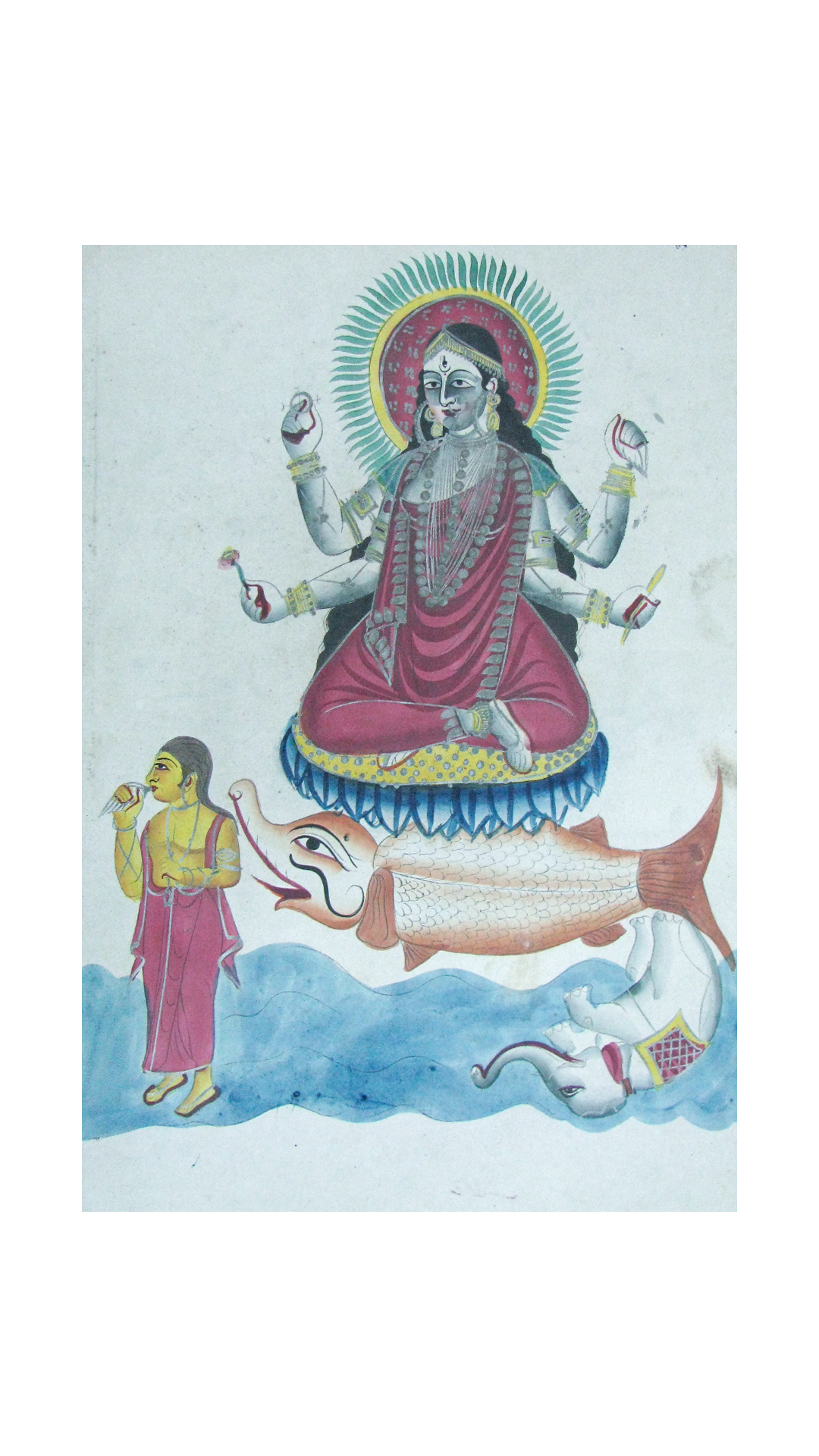
(https://csmvs.in/collections/river-ganga/)
In the painting, Ganga holds a chakra (discus) and padma (lotus) in her right hands, while her left hands hold a shankha (conch) and a water lily. Kalighat paintings, which originated near the Kalighat Temple in Kolkata in the 19th century, often feature such depictions of Ganga. Raja Ravi Varma further popularized this portrayal with his artworks, including the painting “Ganga Bhishma,” which depicts Ganga fleeing with the infant Bhishma in her arms.
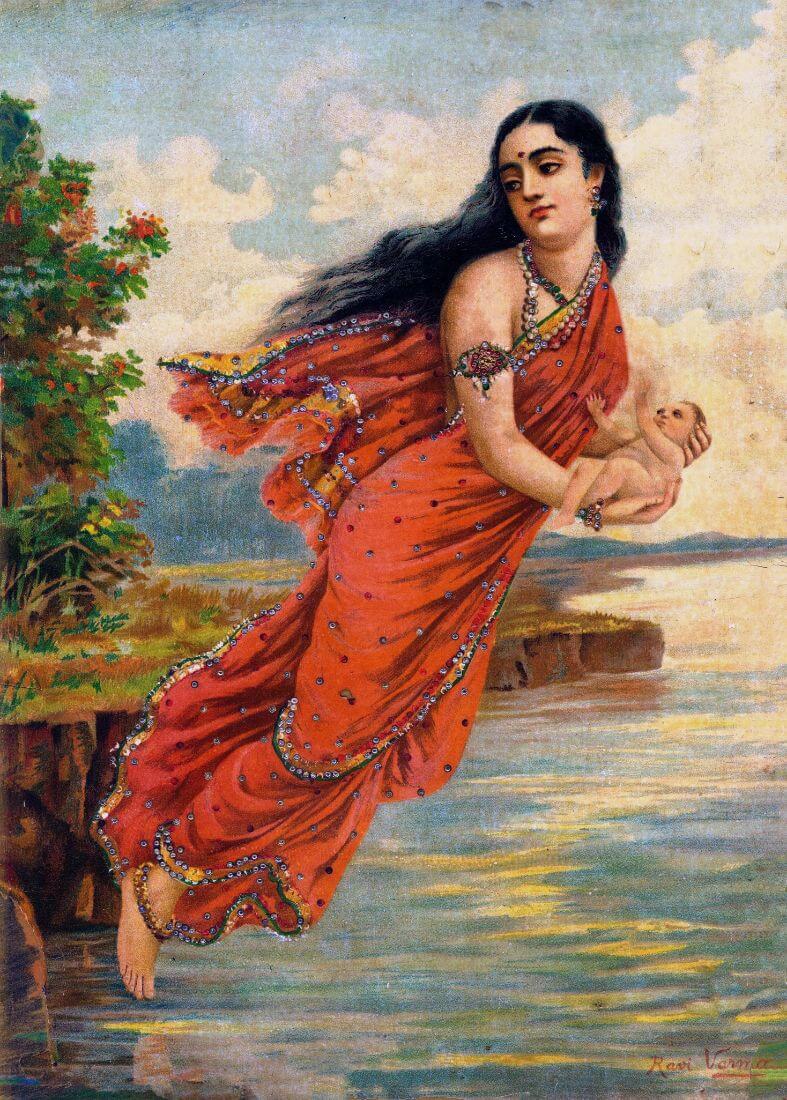
( Ganga Bhishma via www.tallengestore.com)
Another significant artwork, “Gangavataran” (The Descent of Ganga), shows a dreadlocked Shiva standing majestically as he directs Ganga’s powerful flow into his hair to control it.
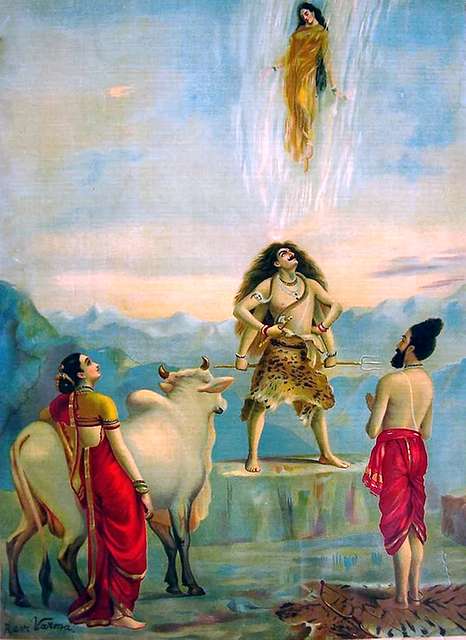
(Gangavataran via artsandculture.google.com)
In “Ganga and Shantanu,” the river goddess is depicted, as Shantanu tries to stop her from drowning their eighth child.
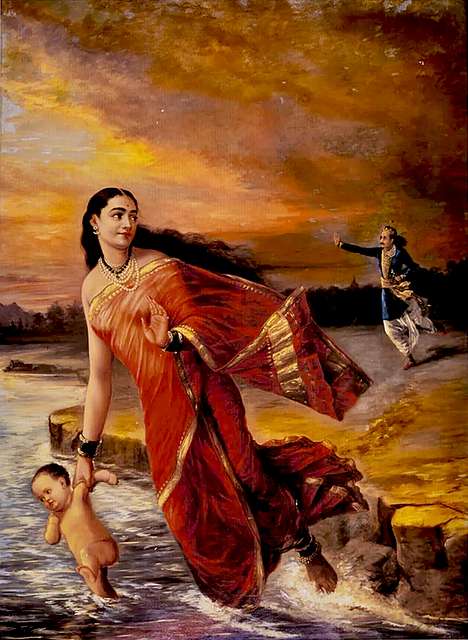
(“Ganga and Shantanu” via picryl.com)
All of these artworks by Raja Ravi Verma exhibit the feminine qualities attached to Sacred rivers in Indian culture. Diana L. Eck (2015) underscores the significance of Ganga in Hindu religion and in India’s religious consciousness, noting that Ganga, as a goddess, transcends her identity as a mere river. She serves as the archetype of sacred waters in India, with other rivers often being compared to or even identified as the Ganga, such as the Kaveri, known as the ‘Ganga’ of South India. However, the Ganga remains the ultimate sacred river, to which all others are likened.
Ganga – Yamuna in Sculptures
From the Rig Veda to the epics Ramayana and Mahabharata, and in classical works like Kalidasa’s poetry, Ganga and Yamuna rivers have held a significant place in Indian culture. Kalidasa’s vivid similes describe the confluence of the White Ganges and Dark Yamuna as resembling a necklace of pearls and blue sapphires, or moonlight peeking through dark leaves. The Padma Purana philosophically interprets their joint representation, suggesting that Yamuna symbolizes ‘pravritti’ (the motive force of worldly activity), while Ganga represents ‘nivritti’ (the cessation of desires and activities). Rising from the Yamunotri glacier in the Himalayas, the Yamuna flows for 1,380 kilometers, almost parallel to the Ganga.
In ancient Indian art, particularly during the Gupta and post-Gupta periods, Ganga and Yamuna are frequently depicted as river goddesses flanking temple entrances. Sacred waters in Indian architecture of Gupta period are typically portrayed as the goddesses standing on their respective vāhanas—Ganga on a crocodile and Yamuna on a tortoise. By the 5th century CE, Ganga’s depiction as a door guardian became a staple in temple architecture, as seen in the Dasavatara Temple at Deogarh, where she and Yamuna are carved on the doorway jambs.
Another set of statues from the ancient city of Ahichchatra, currently housed in the Delhi National Museum, depict the goddesses with upraised hands holding pots that symbolize life-giving waters—a motif also seen in the personification of rivers in ancient Rome and Egypt. Ganga, on the left, stands on a makara while Yamuna, on the right, stands on a tortoise, symbolizing the religious significance of Ganga and Yamuna.
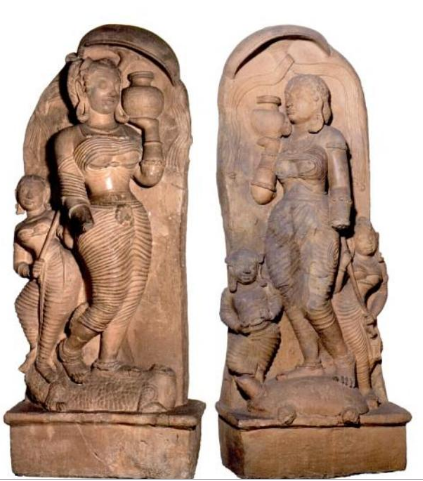
(via www.art-and-archaeology.com)
A dramatic representation of Ganga’s descent from the heavens can be found at Mamallapuram, near Madras. This deserted seaport, once the harbor for Conjeeveram, the Pallava empire’s capital in the 7th century CE, features a colossal relief known as “The Descent of Ganga.” Carved into the granite , it depicts the river rushing from its Himalayan source, symbolizing its divine origins.
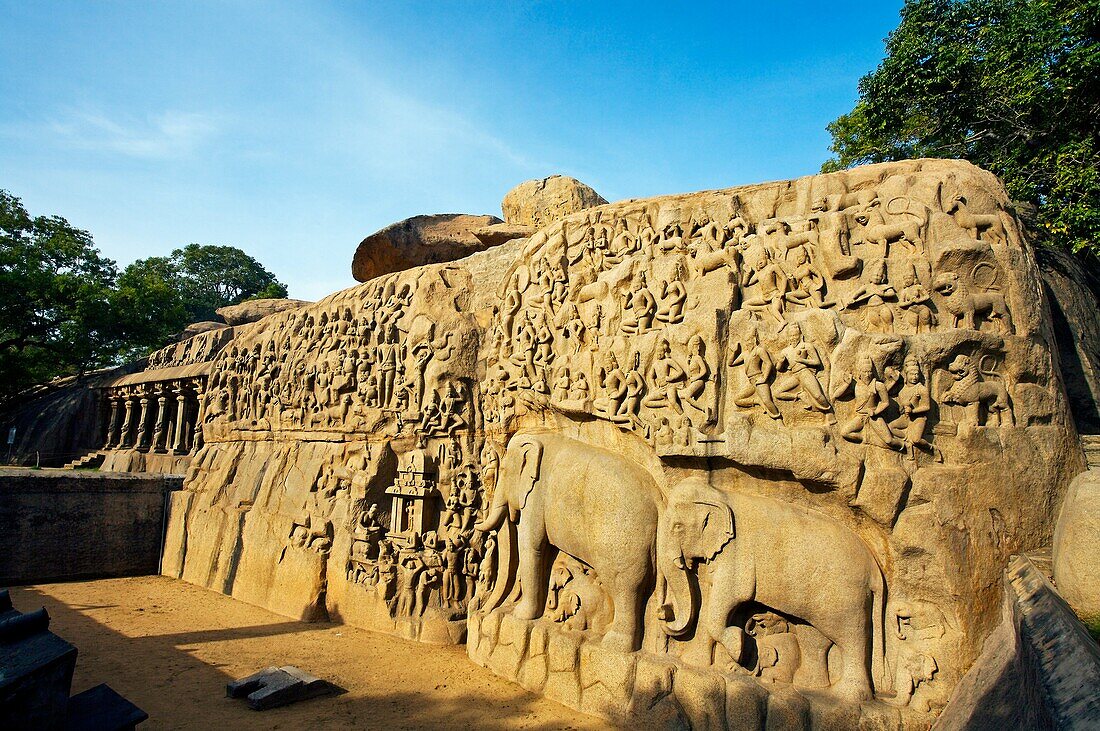
(via www.mahabalipuram.org)
Yamuna – as backdrop of landscapes
According to the Puṣṭimārg sect founded by Sri Vallabhacarya, Yamuna is revered as the fourth consort of Krishna, and she is also known as Kālindi in later texts. Among the Vaishnavas, Yamuna often holds greater appeal than Ganga. Thud the Yamuna River has been a significant subject in , Indian art history, depicted either as a goddess or as the backdrop for important events in the lives of gods, goddesses, and people living along its banks. Her role is pivotal in Krishna mythology, where she serves as an animated landscape, divine consort, and idyllic pastoral setting. One of the iconic scenes under Religious art and Indian rivers include Krishna’s father carrying him across the river on a stormy night, where Yamuna calms herself to facilitate their journey.
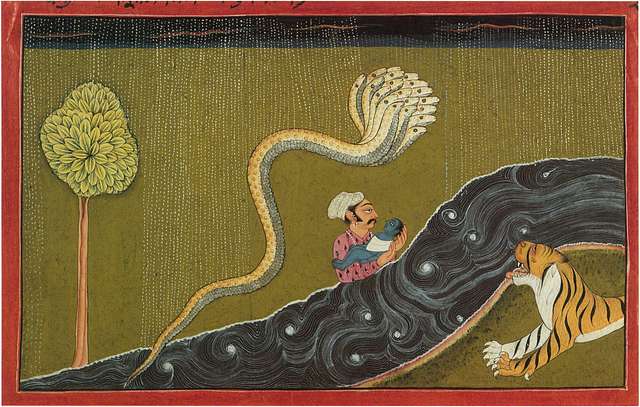
(Vasudeva Takes the Infant Krishna Across the Yamuna River, Folio from a Bhagavata Purana series as No. 42. Master at the Court of Mankot c. 1700. Via picryl.com)
Enriching the Cultural importance of Yamuna, an artwork featuring the river depicts Balaram diverting the course of the river with his Plough, ca. 1760–1765.
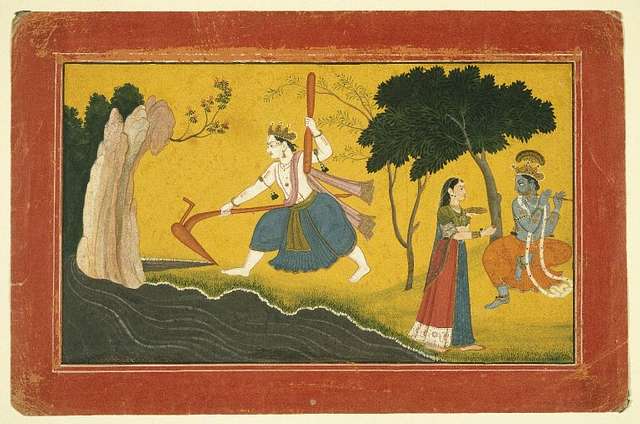
(via https://www.brooklynmuseum.org/opencollection/objects/46213)
The narratives related to Sacred rivers in Indian culture come to life in numerous Pahari and Rajasthani paintings, where Krishna is often depicted playing his flute along the banks of the Yamuna. One particularly painting illustrates an episode from the ‘Gita Govinda’. In this scene, the Divine Couple embraces, encircled by gopis (milkmaids) who yearn for the Lord. It is suggested that this series may have been created for Maharaja Sansar Chand of Kangra’s first wedding in 1781.
Conclusion
The reverence for the Ganga and Yamuna goes beyond their physical presence, reflecting a deep-rooted belief in their divine significance. Vision is inherently subjective and complex, influenced by personal beliefs and cultural contexts. Various cultures hold different elements of the natural world—such as mountains, lakes, springs, and rivers—as sacred, reflecting their unique religious ecology . The Ganga and the Yamuna river symbolism portrays them as extremely pure and life-giving embodying both spiritual and nurturing qualities. However, in the modern times the paradox of environmental degradation is challenging their sacred purity. To address this, it is essential to reconcile nature worship with contemporary principles of sustainability and conservation. This reconciliation highlights the interwoven dynamic between spiritual reverence and practical concerns, underscoring the need for a balanced approach to preserving these sacred rivers. The Ganga and Yamuna remain quintessential symbols of divine presence, bridging the realms of art, mythology, culture, and environmental stewardship.
References –
Baca, Emily Anne. “The Ganges river: Symbology, sustainability, and the confluence of cultural and fluvial connectivity.” (2015).
Pigoniowa, Mariola. “Between the River and the Woman: Ganga in Kalidasa’s Meghadūta.” Cracow Indological Studies, vol. 4-5, 2002-2003, pp. 205-217.
Chattaraj, Arpita. “Sacred Water and Cultures of Worship: Some Observations on the River in India.” Humanities Bulletin 4.2 (2021): 168-183.
Sinha, Amita, and D. Fairchild Ruggles. “The Yamuna riverfront, India: A comparative study of Islamic and Hindu traditions in cultural landscapes.” Landscape journal 23.2 (2004): 141-152.
Rao, Nalini. “Ganges in Indian Sculpture and Literature: Mythology and Personification.” Monsoon: South Asian Studies Association Journal 1.1 (2022): 1.
Darian, Steven. “The Ganges in Indian Art.” East and West 23.3/4 (1973): 307-325.
- Cultural importance of Ganga Yamuna
- Ganga and Yamuna in Hindu religion
- Ganga and Yamuna in Indian art
- Ganga Yamuna river symbolism
- Indian art history rivers
- Indian art sacred river depictions
- Religious art and Indian rivers
- Religious significance of Ganga Yamuna
- Sacred rivers in Indian culture
- Sacred waters in Indian architecture

















